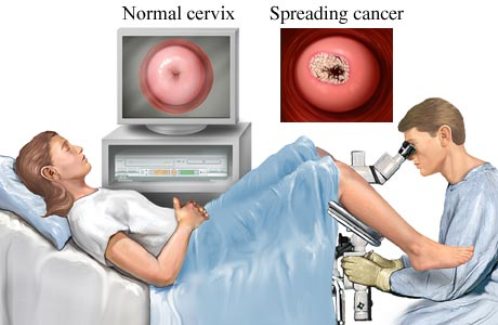
Cervical cancer is the malignancy that starts in the cervix. Cervical cancer instigate from the cells located on the surface of the cervix. Cervical cancer occurs in several forms. The most common is squamous cell carcinoma, which accounts for 85 to 90 percent of cervical cancers. Other forms include adenocarcinomas and combination cancers such as adenosquamous carcinoma. Some strains of the human papillomavirus (HPV), a virus transmitted during sex, play a role in causing most cases of cervical cancer. The type of cervical cancer is determined by the type of cell where the early genetic mutation occurred. The type also helps in determining the specific treatment for a patient. There are two main types of cervical cancer that include:
• Adenocarcinomas: This type takes place in the glandular cells lining the cervical canal. Adenocarcinomas accounts for a smaller portion of all cervical cancers.
• Squamous Cell Carcinomas: This type starts in the flat and thin cells lining the bottom of the cervix. Squamous cell carcinomas make up for a large majority of cervical cancers.
• Abnormal bleeding - Women with cervical cancer may experience abnormal vaginal bleeding. This can be heavy or light bleeding during the month.
• Unusual heavy discharge - An increased vaginal discharge is also a symptom of cervical cancer. It may be foul smelling, watery, thick, or contain mucus. It varies from woman to woman. It is important to report any unusual vaginal discharge to your doctor.
• Pelvic pain - Pelvic pain that is not related to the normal menstrual cycle can be a cervical cancer symptom. Many women describe them ranging from a dull ache to sharp pains that can last hours. It can be mild or severe.
• Pain during urination - Bladder pain or pain during urination can be a symptom of advanced cervical cancer. This cervical cancer symptom usually occurs when cancer has spread to the bladder.

• Pap Smear Test - A Pap smear is an examination under the microscope of cells scraped from the tip of the cervix. Doctors do this by putting an instrument called a speculum inside vagina and then scraping the cervix with a small brush.
• Liquid Based Cytology - Liquid based cytology (LBC) is a way of preparing cervical samples for examination in the laboratory. The sample is collected in a similar way to the Pap smear, using a special device (spatula) which brushes cells from the neck of the womb.
• Hybrid Capture II Test - The Hybrid Capture II HPV test tells if treatment is essential for women or not. It is a DNA based test that provides information about 13 types of HPV virus that might be the agent of infection of cervical cells.
• Colposcopy - A colposcopy is a special way of looking at the cervix. It uses a light and a low-powered microscope to make the cervix appear much larger. This helps your health care provider find and then biopsy abnormal areas in your cervix.
• Loop Electrosurgical Excision Procedure (LEEP) - The test involves the use of an electrode put inside the cervix to remove abnormal cells from the cervix and endo-cervical canal. A high frequency electric current is running through the wire.
• Magnetic Resonance Imaging (MRI) - This test uses magnetism to build up pictures of the organs in your abdomen. It is very good at imaging the tissues of the pelvis where the cancer is. MRI is painless, and the magnetism is harmless.
• Computerized Tomography (CT) Scan - A CT scan is a type of x-ray that gives a cross-sectional picture of organs and other structures (including any tumours) in your body.
• A Positron Emission Tomography (PET) - A positron emission tomography (PET) scan can check to see if cancer has spread to other parts of the body.
• Blood tests. Based on the doctor's evaluation, the cancer will be classified into one of more than 10 substages. Staging helps Gyneconcologist determine what treatments may be more effective. In general, stages for cervical cancer include:
o Stage 0 or carcinoma in situ. Stage 0 cancer is preinvasive cancer, and abnormal cells appear only in the first layer of cells that line the cervix.
o Stage I. Stage I cancer is confined to the cervix. Gyneconcologist may further classify it as Stages IA1, IA2, IB1 or IB2 depending on the size of the tumor and how deeply the cancer has invaded.
o Stage II. Stage II cancer has spread beyond the uterus, but not to the pelvic sidewall or the upper third of the vagina. Gyneconcologistmay classify it as Stage IIA or IIB.
o Stage III. In Stage III, the cancer extends to the pelvic wall or the lower third of the vagina or causes expansion of the ureters, resulting in kidney problems. Gyneconcologistmay classify it as Stage IIIA or IIIB based on whether cancer cells have extended to the sidewall of the pelvis.
o Stage IV. In Stage IV, the cancer has invaded the bladder or rectum and may extend beyond the pelvis. Gyneconcologistmay identify it as Stage IVA or IVB.

Surgery
The following surgical procedures may be used as part of cervical cancer treatment:
• Conization - Conization, also called a cone biopsy, is a procedure that is used to remove a cone-shaped piece of tissue from the cervix and cervical canal. A pathologist will view the tissue under a microscope to look for cancer cells. This type of surgery may be used to diagnose or treat a cervical condition.
• Hysterectomy - A hysterectomy (removal of the uterus but not the ovaries) is not often performed for cervical cancer that has not spread. It may be done in women who have repeated LEEP procedures.
• Radical Hysterectomy - Radical Hysterectomy removes the uterus and much of the surrounding tissues, including lymph nodes and the upper part of the vagina.
• Cryosurgery - Cryosurgery is a treatment that uses an instrument to freeze and destroy abnormal tissue, such as carcinoma in situ. This type of cervical cancer surgery is also called cryotherapy.
• Laser Surgery - Laser surgery is a procedure that uses a laser beam (a narrow beam of intense light) as a knife to make bloodless cuts in tissue or to remove a surface lesion such as a tumor.
• Pelvic Exenteration - Surgery to remove the lower colon, rectum, and bladder. In women, the cervix, vagina, ovaries, and nearby lymph nodes are also removed. Artificial openings (stoma) are made for urine and stool to flow from the body to a collection bag. Plastic surgery may be needed to make an artificial vagina after this operation.
Treatment for cervical cancer includes hysterectomy, radiation therapy and chemotherapy. The form of treatment varies based on the stage at which the cancer was detected.
Radical Hysterectomy for Cervical cancer Treatment: A Radical Hysterectomy is the procedure by which the uterus and the cervix are removed surgically. This procedure is performed to treat certain gynecological conditions such as cervical cancer and fibroids etc. Additionally, depending on the stage of the cancer pelvic lymph nodes and ovaries might be surgically removed.
Chemotherapy for Cervical Cancer Treatment: Chemotherapy is the use of medicine to cure cancer. Chemotherapy can be administered intravenously, intramuscularly orally or topically and several other ways. The medicine travels throughout the body and also to the cancerous organ. Once at the target organ the medicine kills the cancer cells by cutting of vital pathways in the cell cycle. Chemotherapy can have temporary and permanent side. Some individuals experience nausea and vomiting while others may become infertile.
Radiation Therapy for Cervical cancer Treatment: Radiation therapy uses a high intensity X rays to kill cancer cells. Radiation therapy can utilize radiation from an external machine by using radioisotopes inside the body. Unlike chemotherapy treatment, radiation therapy can be applied only to the area in which cancer cells are present. This form of therapy is often used in conjunction with chemotherapy and/or hysterectomy.
Treatment of cervical cancer depends greatly on the stage at which the cancer was detected. Advanced stage cancers will require aggressive treatment while initial stages can be treated relatively quickly.

Mr.Gilbert, Knee Replacement, Nigeria
Mr.Gilbert from Aba, Nigeria who came to India for his knee replacement in India.
Mrs. Kalangwa George, Lung Cancer, Kenya
Mrs. Kalangwa George from Mombasa, Kenya who came to India for her Lung Cancer Treatment in India.
Mrs. Elisabeth, Breast Cancer Surgery, Nigeria
Mrs. Elisabeth from Kano, Nigeria who came to India for the Breast Cancer Surgery.
Mr.Tselmeg, Kazakhstan, Spine Surgery
Mr.Tselmeg from Astana, Kazakhstan who came to India for the Spine Surgery
Mr. Stephen Okafor, Spine Surgery, Nigeria
Mr. Stephen Okafor from Onitsha, Nigeria who came to India for the Spine Surgery
Mrs. Asiata Nofiu, Laparoscopic Ovarian Cystectomy , Nigeria
Mrs. Asiata Nofiu from Lagos, Nigeria who came to India for the Laparoscopic Ovarian Cystectomy
Mr. Alhassan Osman, Prostate Treatment, Tanzania
Mr. Alhassan Osman from Mwanza, Tanzania who came to India for the Prostate Treatment
Mr. Okubowa Babatunde , Heart Surgery , Zimbabwe
Mr. Okubowa Babatunde from Harare, Zimbabwe who came to India for the heart hole surgery